|
HMP 729G, GPF 146G and LGW 809G
The stars of The Italian Job were three
Mk1 Austin Mini Cooper S's, in red, white
and blue of course. The distinct characteristics
are their unique 'Moustache' grill trim,
sliding windows, external door hinges,
early type boot locks, hinged number plates
and hook-type door handles.
At the hands of L'Equipe Remy Julienne's
stunt drivers they became legends. Surprisingly
not many modifications were made to the
cars for their jaw dropping stunts. It's
normal for 'movie' cars to be heavily
modified to cope with the strains of stunt
driving, but because the Coopers were
race bred, they were incredibly tough
in all the right areas, as well as being
extremely lightweight. The only real problem
that the Coopers posed the stunt drivers
was the low ground clearance.
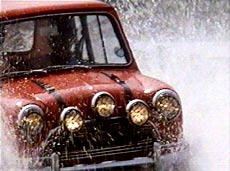
HMP 729G |
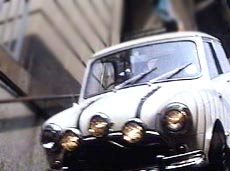
GPF 146G |
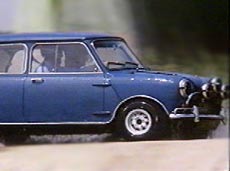
LGW 809G |
All
the Minis featured three-point rollcages
and had the back seats removed. Anyone
who believes that Minis are not 'Rigid'
enough should take a good look at the
cars which are thrown out of the bus at
the end as they roll down the mountain.
If anything they are too rigid for modern
crash standards, and don't crumple readily
enough.
Michael Caine has gone on record as saying
that BMC refused to help with the production.
However, several people who were working
for BMC at the time have gone on record
as saying at least one Mini was specially
prepared for the film, being equipped
with the BMC 1800cc B-series engine and
gearbox from the BMC 1800 'Landcrab',
as the Coopers lacked sufficient torque
to climb stairs.
No-one really knows what happened to the
fleet of surviving Minis that were used
on the set. As far as figures go, the
production crew bought 6 Coopers and an
extra 25 Mini's from Switzerland, but
it's unsure how many of these were Coopers
or regular Mini's. Approximately sixteen
Cooper S's were used during filming. The
Cooper's that were thrown out of the coach
were in fact regular Mini's dressed up
like Coopers. Ken Morris, one of the last
of the production crew members to leave
after filming in Turin stated that there
were six surviving Mini's and 30 sets
of mag wheels in the lock up garage that
they were using. He said that he locked
up and headed for the UK, and as far as
he was aware neither Paramount or production
company Oakhurst returned to collect them!
Practice
Coopers
During the training for the job, Charlie
gets his Mini drivers to practice entering
the coach, using a ramp and a brick wall.
Two Coopers were used in this scene, a
red one, registration OEG 103G, and a
blue one, registration WGH 415G. In the
below mid-left photo, you can see the
black E-Type Jaguar - in fact all the
fast cars were parked up there.
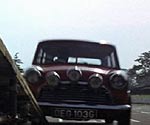
You're meant to use... |
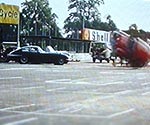
...your brakes Chris... |
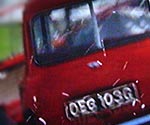
S....So..Sorry Charlie!
|
|
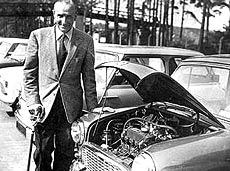
Sir Alec Issigonis
by a 1959 Mini |
Mini... a brief history
BMC wanted a vehicle to compete with the
German bubble cars, which had been born
out of the 1950's fuel crisis. BMC's top
designer (Sir) Alec Issigonis was set
to work. Issigonis, was a genius, the
Mini was entirely his work and not the
work of a entire design team. He designed
the Mini to be a small, cheap, economical
car with safe handling... he even designed
the engineering tools that made the Mini.
He had great visualisation skills and
the Mini was designed as it was being
prototyped. An engineer asked him what
size to make the wheels, Issigonis held
his hands apart and said "this big"...the
engineer measured the distance between
his hands - 10 inches - and made the wheels
exactly that size! Casual sketches made
my Issigonis could almost be used as blueprints
by the engineers assembling the first
prototypes. He preferred to be hands-on
rather than paper-based, and called himself
"The Ironmonger".
The Mini was revolutionary, with front
wheel drive, the gears mounted in the
engine's sump and a transverse engine.
The entire engine and transmission unit
was contained on subframes and fitted
compactly under the Mini's tiny bonnet.It
was also VERY small - just over 10 feet
long - which made it all the more incredible
that it could take 4 people and (some)
of their luggage.
The press loved the Mini on it's launch
in 1959, but sales were unimpressive.
It was only after well known celebrities
such as Paul McCartney and Twiggy became
owners that the sales went through the
roof - in 'swinging' London it quickly
became the coolest car to be seen in.
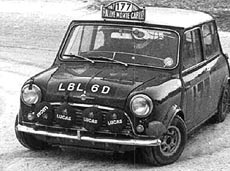
Rauno Aaltonen,
1967 Monte Carlo Rally Winner |
The
Iconic Cooper S
The famous Grand Prix team, John Cooper
Racing realised how superbly the Mini
handled and quickly got involved. Motor
racing driver John Cooper quickly developed
a souped-up version of the Mini in 1961
and it soon became a racing legend and
produced a succession of performance models.
The
Mini Cooper's pin-sharp handling and superior
power-to-weight ratio made it a force
to be reckoned with and could compete
with much bigger and more powerful machinery.
The Cooper went on to many successes in
rallying, most notably the Monte Carlo
Rally (won in 1964, 65 & 67) as well
as various road circuits.
John Cooper persuaded the Mini's creator,
Sir Alec Issigonis, to let him produce
a high-performance version of the car
even though Sir Alec did not believe it
would sell. But the car was an immediate
success and the more powerful Cooper S,
which followed in 1963, was an even bigger
hit.
Even in 1999 Mini Coopers still accounted
for half of all Minis which left the forecourts
- about 10,000 cars a year.
Back
to Top
|